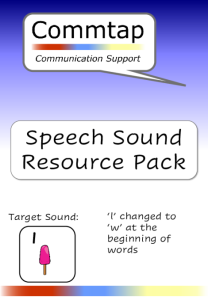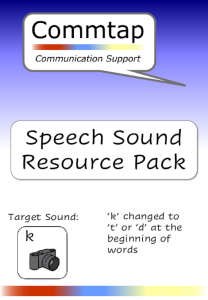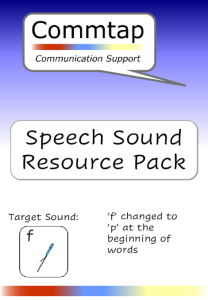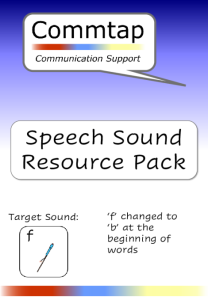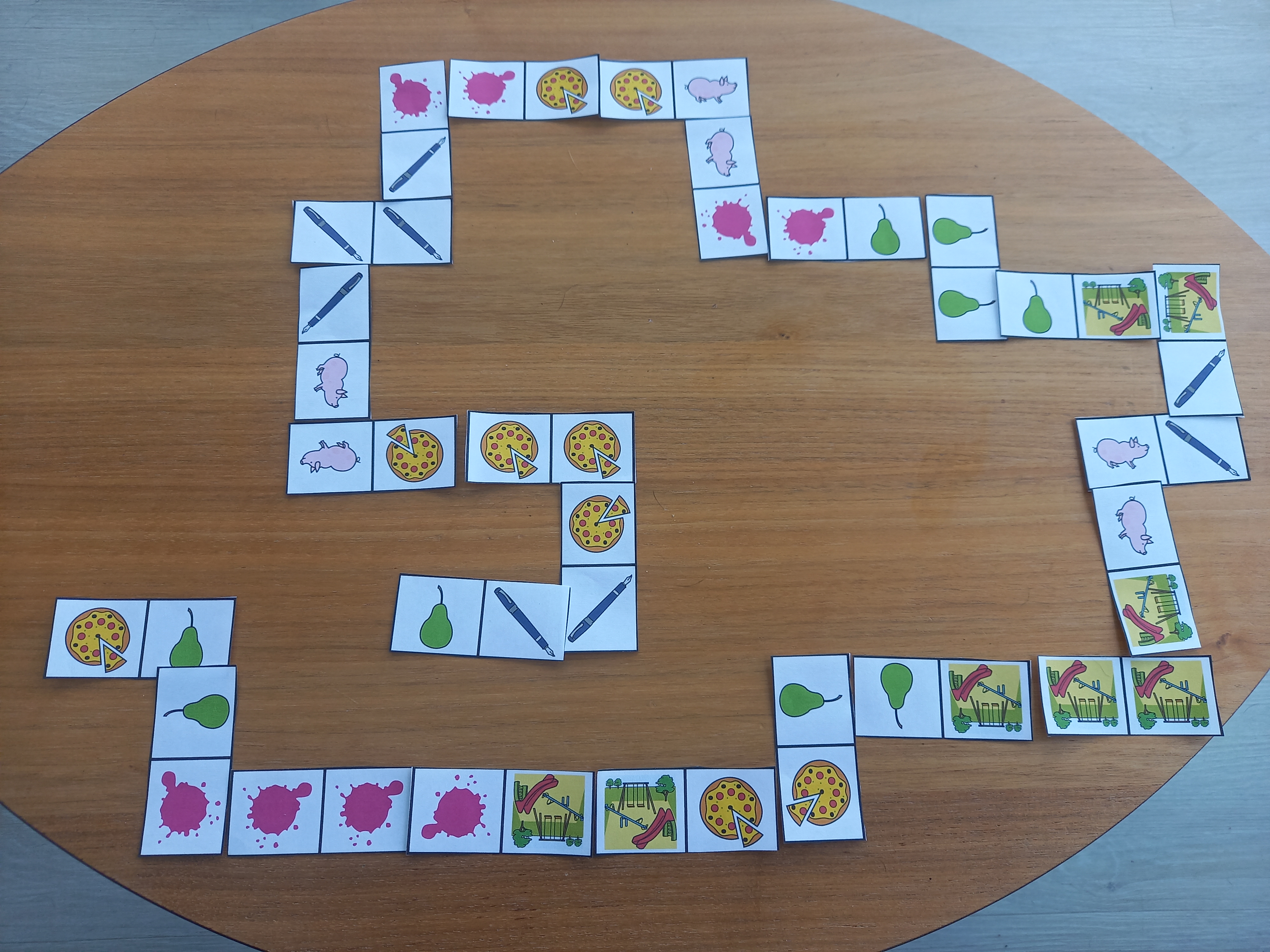Search
User login
Topic “Syllable Initial Word Initial”
Use 'L' Instead of 'w' - Word Initial Speech Sound Pack
Support a child who is using "w" instead of "l" in their speech. For example saying "wight" instead of "light". This pack takes you through the following steps:
- Building awareness of sounds
- Saying "l" on its own
- Saying "l" with a vowel
- Using "l" in individual words
- Using "l" in words in phrases
- Using "l" in sentences
- Using "l" in conversations
Created 29 May 2023; updated 9 June 2023.
Use 'L' Instead of 'n' - Word Initial Speech Sound Pack
Support a child who is using "n" instead of "l" in their speech. For example saying "night" instead of "light". This pack takes you through the following steps:
- Building awareness of sounds
- Saying "l" on its own
- Saying "l" with a vowel
- Using "l" in individual words
- Using "l" in words in phrases
- Using "l" in sentences
- Using "l" in conversations
Created 29 May 2023; updated 9 June 2023.
Use 'k' Instead of 't' or 'd' - Word Initial Speech Sound Pack
Support a child who is using "t" or "d" instead of "k" in their speech. This pack takes you through the following steps:
- Building awareness of sounds
- Saying "k" on its own
- Saying "k" with a vowel
- Using "k" in individual words
- Using "k" in words in phrases
- Using "k" in sentences
- Using "k" in conversations
Created 29 May 2023; updated 28 December 2023.
Use 'f' Instead of 's' - Word Initial Speech Sound Pack
Support a child who is using "s" instead of "f" in their speech. This pack takes you through the following steps:
- Building awareness of sounds
- Saying "f" on its own
- Saying "f" with a vowel
- Using "f" in individual words
- Using "f" in words in phrases
- Using "f" in sentences
- Using "f" in conversations
Created 29 May 2023; updated 9 June 2023.
Use 'ch' Instead of 'd' or 't' - Word Initial Speech Sound Pack
Support a child who is using "t" or "d" instead of "ch" in their speech. This pack takes you through the following steps:
- Building awareness of sounds
- Saying "ch" on its own
- Saying "ch" with a vowel
- Using "ch" in individual words
- Using "ch" in words in phrases
- Using "ch" in sentences
- Using "ch" in conversations
Created 29 May 2023; updated 9 June 2023.
Use 'f' Instead of 'p' - Word Initial Speech Sound Pack
Support a child who is using "p" instead of "f" in their speech. This pack takes you through the following steps:
- Building awareness of sounds
- Saying "f" on its own
- Saying "f" with a vowel
- Using "f" in individual words
- Using "f" in words in phrases
- Using "f" in sentences
- Using "f" in conversations
Created 29 May 2023; updated 9 June 2023.
Use 'f' Instead of 'b' - Word Initial Speech Sound Pack
Support a child who is using "b" instead of "f" in their speech. This pack takes you through the following steps:
- Building awareness of sounds
- Saying "f" on its own
- Saying "f" with a vowel
- Using "f" in individual words
- Using "f" in words in phrases
- Using "f" in sentences
- Using "f" in conversations
Created 29 May 2023; updated 9 June 2023.
Using a target sound in a single word - activities/games set 1
| Activity/strategy name and materials required | How to do the activity | Key principles for doing the activity and comments |
|---|---|---|
| Sound Dominoes |
| If your child is able to do this activity you might like to try moving on to: saying a small phrase with the target word in, e.g target word = 'car', your phrase could be, 'a red car'. Some phrase level activities can be found by clicking here.
If your child is finding this activity challenging, try the following steps: - If your child finds it challenging to say the sound, praise them for trying and say the word back with the sound used correctly for them to hear. - Talk about the sound the word starts with, e.g. 'cat' starts with a 'c' sound. - Have a go at breaking the word up for the child to copy, e.g. 'let's try and say this together, 'c' 'at'. |
| 4 in a Row! - Printable template with playing board and counters. - Words containing your child's target sound - click here for printable word cards. | If your child is able to do this activity you might like to try moving on to: saying a small phrase with the target word in, e.g target word = 'car', your phrase could be, 'a red car'. Some phrase level activities can be found by clicking here.
If your child is finding this activity challenging, try the following steps: - If your child finds it challenging to say the sound, praise them for trying and say the word back with the sound used correctly for them to hear. - Talk about the sound the word starts with, e.g. 'cat' starts with a 'c' sound. - Have a go at breaking the word up for the child to copy, e.g. 'let's try and say this together, 'c' 'at'. | |
| Washing Line - Strong string or rope - pegs - Words containing your child's target sound - click here for printable word cards. - small bag to put picture cards in | If your child is able to do this activity you might like to try moving on to: saying a small phrase with the target word in, e.g target word = 'car', your phrase could be, 'a red car'. Some phrase level activities can be found by clicking here.
If your child is finding this activity challenging, try the following steps: - If your child finds it challenging to say the sound, praise them for trying and say the word back with the sound used correctly for them to hear. - Talk about the sound the word starts with, e.g. 'cat' starts with a 'c' sound. - Have a go at breaking the word up for the child to copy, e.g. 'let's try and say this together, 'c' 'at'.
| |
| What's in the bag? Guessing Game - Words containing your child's target sound - click here for printable word cards. - bag | If your child is able to do this activity you might like to try moving on to: saying a small phrase with the target word in, e.g target word = 'car', your phrase could be, 'a red car'. Some phrase level activities can be found by clicking here.
If your child is finding this activity challenging, try the following steps: - If your child finds it challenging to say the sound, praise them for trying and say the word back with the sound used correctly for them to hear. - Talk about the sound the word starts with, e.g. 'cat' starts with a 'c' sound. - Have a go at breaking the word up for the child to copy, e.g. 'let's try and say this together, 'c' 'at'. | |
| Kim's Game - Words containing your child's target sound - click here for printable word cards. - A blanket or tea towel | If your child is able to do this activity you might like to try moving on to: saying a small phrase with the target word in, e.g target word = 'car', your phrase could be, 'a red car'. Some phrase level activities can be found by clicking here.
If your child is finding this activity challenging, try the following steps: - If your child finds it challenging to say the sound, praise them for trying and say the word back with the sound used correctly for them to hear. - Talk about the sound the word starts with, e.g. 'cat' starts with a 'c' sound. - Have a go at breaking the word up for the child to copy, e.g. 'let's try and say this together, 'c' 'at'. |
Resources for Listening and Auditory Discrimination Tasks
Minimal Pair Resources
- Noisy/quiet sounds
- p and b at the beginning of words
Auditory discrimination of minimal pairs
| Activity/strategy name and materials required | How to do the activity | Key principles for doing the activity and comments |
|---|---|---|
| Main instructions Pictures of minimal pair words (e.g. key/tea) - photocopy them on to card (e.g. 6 of each word) so that you can't see through the card. | 1. Put one of each picture (e.g. key and tea) on the table, face up. 2. Mix up the rest of the pictures and put them in a pile face down. 3. Take one picture from the pile, don't let the person see it! 4. Say what is on the picture (e.g. key). 5. Make sure you present the pictures in a random order so that the person can't predict what's coming next. 6. The person has to find the appropriate picture on the table. | These are the main instructions for the activities. Use this with the games below. |
| Lotto game Lotto boards (4 pictures to a board. Use pairs of words from the list above, but do not put both words of a pair on the same board) Corresponding picture cards |
Identifying and saying the correct sound blend at the beginning of words
| Activity/strategy name and materials required | How to do the activity | Key principles for doing the activity and comments |
|---|---|---|
| Stick it - A piece of paper for each of the blend sounds you are working on, e.g. for 's' blends you would have 'sc/sk' 'sl' 'sm' 'sn' 'sp' 'st' 'sw' - Glue/Blu-tac - Pen/pencil - Feely-bag/ other container - A selection of picture cards with words starting with your target blends/clusters - this will either be 's' blends, 'l' blends or 'r' blends - click here for printable picture cards. | 1. Help the child to write a different sound blend in the centre of each sheet of paper. 2. Put all the pictures in the feely-bag or container. Shake it to mix them up. 3. Ask the child to pull one picture out of the feely-bag. 4. Ask them to say the name of the picture. Give them a clue if they are not sure what the picture shows. Model the correct pronunciation if the child says it wrong. 5. Ask the child to stick the picture on the correct piece of paper according to the blend at the start of the word. (Use Blu-tac if you want to be able to re-use the pictures). 6. Repeat until all the pictures have been used up. | If the child finds it hard to hear the cluster at the start of the word when they say it themselves, you could say it to them. If they still find it hard, say the word with a short break after the cluster, e.g. "sk...irt". If the child mispronounces the word say the word both correctly and the way the child says it, and ask them which is the correct one e.g. "is it 'stooter' or 'scooter'?" |
- « first
- ‹ previous
- 1
- 2
- 3
Support Commtap to keep it online
Thank you for visiting Commtap.
Please read this message as it is extremely important.
- Visitor donations mean we can continue to host over 1,000 free activities to support speech, language, and communication development.
- Visitor donations mean we can continue to provide free resources to address a wide range of communication needs, including limited speech or language, interaction challenges, and needs associated with conditions such as developmental language disorder, autism, and cerebral palsy.
- Visitor donations mean we can continue to provide resources to support the work of speech and language therapists, teachers, teaching assistants, parents, and carers.
- Visitor donations mean we can continue to provide the free key word sign dictionary (bks.org.uk) which has over 2,000 Makaton and Signalong signs.
We know that not everyone is able to afford to pay to access these resources, however, if you can, please make a donation to keep the site going.
Thank you
Google ads on this page are provided by Google Adsense - and their presence does not imply any endorsement by Commtap. Report a problem with an ad on this page. Log in (for free) to avoid seeing Google ads.
